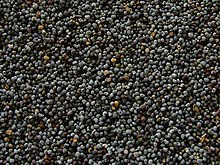Poppy seed oil
| Poppy seed oil, poppy seed oil | |
|---|---|
| Raw material plant (noun) |
Opium poppy ( Papaver somniferum ) |
| origin |
Seeds |
| colour |
pale to light yellow; |
| ingredients | |
| Oleic acid | 10.5-36.8% |
| Linoleic acid | 41-75% |
| Linolenic acid | <1% to 9.4% |
| Palmitic acid | 7.8-21.5% |
| More fatty acids | Stearic acid 1.4-10.9% |
| properties | |
| density | 0.923-0.926 kg / l at 15 ° C |
| viscosity | = 63 mPA · s |
| Oxidation stability | 5.5 h |
| Melting point | −17 ° C |
| Flash point | 255 ° C |
| Iodine number | 128-146 |
| Saponification number | 188-196 |
| Calorific value | 39.6 MJ / kg |
| Cetane number | 36.7 |
| Manufacturing and Consumption | |
| Most important production countries | Czech Republic , Turkey , Spain , Hungary |
| use | Edible oil , cosmetics, technology |
Poppy seed oil, also called poppy seed oil , is a vegetable oil that is obtained from the small seeds of the opium poppy . The European varieties are obtained from blue or gray seeds. The other varieties come from white, brown, or black seeds. The oil is mainly obtained by cold pressing .
It is colorless to pale yellow (white poppy seed oil), almost odorless with a pleasant taste. Hot-pressed oil is golden yellow (red poppy seed oil).
An oil with similar properties can also be obtained from corn poppy seeds .
The yield is between 30 and 40 percent. The oil is also produced in relatively small quantities in Austria , especially in the Waldviertel , and is a relatively expensive, rediscovered niche product . In France it is called "huile blanche", white oil, in English it is called "poppy seed oil".

The cultivation of poppies in the Waldviertel has a long tradition that goes back to the Middle Ages. Back then, monks cultivated poppy seeds to make medicines for pain and insomnia and used the poppy seed oil as lamp oil. Poppy seed oil was also used to make oil paper .
The oil is one of the semi-drying oils and is therefore drying more slowly than linseed oil , it is therefore conditionally suitable as a base material for the production of paints for oil painting .
The triglycerides in the oil of the poppy seeds have a particularly high proportion of the omega-6 fatty acid residue , which is derived from linoleic acid. Because of its intense nutty taste, it is mainly used today as an edible oil for salads and cold dishes. Since it should not be heated above 170 degrees, it is only suitable for roasting and baking to a limited extent.
Poppyseed oil is also used in medical products and cosmetics .
Individual evidence
- ↑ a b c d e Jenő Bernáth: Poppy: The Genus Papaver. Harwood Academic, 1998, ISBN 90-5702-271-0 , p. 384.
- ↑ Bavarian State Ministry for State Development and Environmental Issues: Vegetable oil- powered combined heat and power plants. Part 1, 2002, p. 7, online (PDF; 2.12 MB), lfu.bayern.de, accessed on April 30, 2017.
- ^ Ullmann's encyclopedia of industrial chemistry . Vol. A 10: Fats and oils , VCH, Weinheim 1995.
- ↑ a b c Alain Karleskind: Manuel des corps gras. 2. Volumes, AFCEG, TEC DOC, Paris 1992, ISBN 978-2-85206-662-5 .
- ↑ B. Bozan, F. Temelli: Chemical composition and oxidative stability of flax, safflower and poppy seed and seed oils. In: Bioresource Technology. Volume 99, Issue 14, 2008, pp. 6354-6359, doi : 10.1016 / j.biortech.2007.12.009 .
- ↑ a b D. K. Salunkhe: World Oilseeds. Van Nostrand Reinhold, 1992, ISBN 0-442-00112-6 , p. 455.
- ↑ MA Rakusin: The investigation of petroleum and its products. Vieweg, 1906, Let Me Print 2013, ISBN 978-5-87762-073-5 (Reprint), p. 152.
- ↑ Ayhan Demirbas: Biodiesel. Springer, 2008, ISBN 978-1-84628-995-8 , p. 78.
- ^ Forest Gregg: SVO. New Society, 2008, ISBN 978-0-86571-612-4 , p. 47.
- ↑ FAO statistics 2014 .
- ↑ a b Emil Abderhalden (Ed.): Biochemisches Handlexikon. 3rd volume, Springer, Berlin 1911, ISBN 978-3-642-51194-3 , p. 29.
- ↑ W. Awe, G. Kunert: The oil of the corn poppy seeds (Papaver Rhoeas) in comparison with the opium poppy oil (Papaver somniferum). In. Fat soaps. 52 (5), 1950, pp. 268-273. doi : 10.1002 / lipi.19500520503 .
- ^ Dole Food Company: Encyclopedia of Foods. Academic Press, 2002, ISBN 978-0-12-219803-8 , p. 398.
- ↑ Sabine Krist u. a .: Analysis of Volatile Compounds and Triglycerides of Seed Oils Extracted from Different Poppy Varieties (Papaver somniferum L.). In: J. Agric. Food Chem. 53 (21), 2005, pp. 8310-8316, doi : 10.1021 / jf0580869 .



